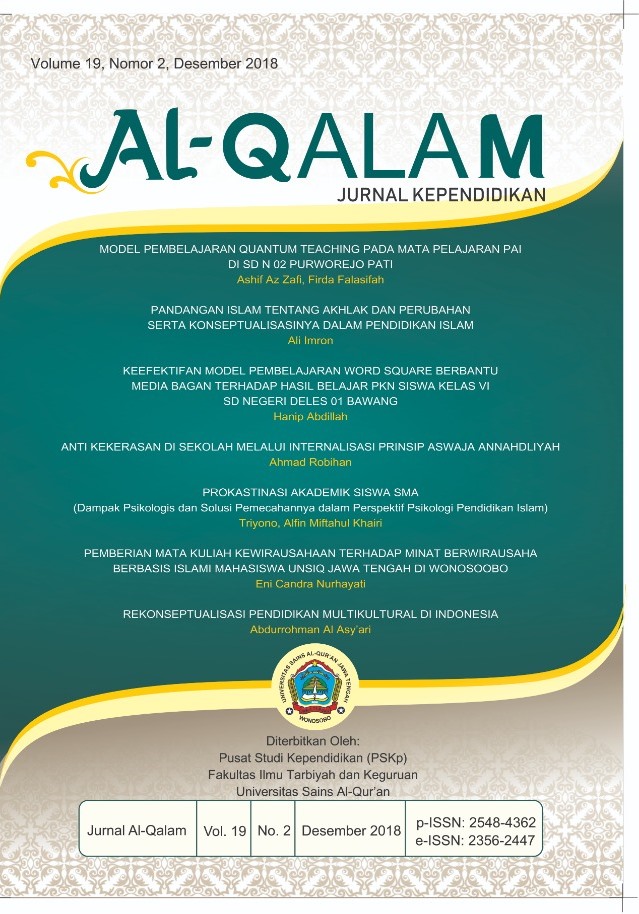INISIASI PEMBELAJARAN MATEMATIKA DENGAN ETNOMATEMATIKA DAN TEORI BELAJAR BRUNER
DOI:
https://doi.org/10.32699/al-qalam.v24i2.7581Abstract
Mathematics can be considered a difficult subject by some people because it requires the ability to think abstractly. The power of abstraction in mathematics refers to a person's ability to think conceptually and generalize patterns found in a mathematical context. The purpose of this research is to initiate the development of mathematics learning using ethnomathematics and Bruner's theory of learning, aiming to facilitate students in mastering mathematical concepts that require high abstraction. This research employs a literature review method and utilizes discourse analysis as the data analysis technique. Ethnomathematics involves utilizing and integrating cultural practices and mathematics within society to enhance students' understanding of mathematical concepts. This approach is integrated with Bruner's learning theory by incorporating cultural elements into the stages of enactment, iconic representation, and symbolic representation. By combining these two theories, a deeper understanding of mathematics is expected, connecting the learned theories with students' cultural backgrounds and experiences. Thus, mathematics learning is anticipated to become more meaningful and relevant to the realities faced by students in their daily lives.
References
Anggito, A., & Setiawan, J. (2018). Metodologi penelitian kualitatif. CV Jejak (Jejak Publisher).
Balamurugan, M. (2015). Ethnomathematics; an approach for learning mathematics from multicultural perspectives. International journal of modern research and reviews, 3(6), 716-720.
Budiarto, M. T., Masruroh, A., Azizah, A., Munthahana, J., Awwaliya, R., & Yusrina, S. L. (2022). Etnomatematika teori, pendekatan, dan penelitiannya. Zifatama Jawara.
Fattah, B. (2017). Representasi Matematis Peserta Didik Menurut Pandangan Bruner Dalam Menyelesaikan Soal Geometri Ditinjau Dari Kemampuan Matematika dan Jenis Kelamin (Doctoral dissertation, Universitas Muhammadiyah Gresik).
Hatip, A., & Setiawan, W. (2021). Teori kognitif bruner dalam pembelajaran matematika. PHI: Jurnal Pendidikan Matematika, 5(2), 87-97.
Huda, S. T., & Susdarwono, E. T. (2023). Hubungan antara teori perkembangan kognitif Piaget dan teori belajar Bruner. Jurnal Muassis Pendidikan Dasar, 2(1), 54-66.
Ningsih, S. (2014). Realistic mathematics education: model alternatif pembelajaran matematika sekolah. Jurnal Pendidikan Matematika, 73-94.
Rosa, M & Orey, D.C. (2011). Ethnomathematics: the cultural aspects of mathematics. Revista Latinoamericana de Etnomatemática, 4(2), 32-54.
Rudyanto, H. E., HS, A. K. S., & Pratiwi, D. (2019). Etnomatematika budaya Jawa: Inovasi pembelajaran matematika di sekolah dasar. Jurnal Bidang Pendidikan Dasar, 3(2), 25-32.
Serepinah, M., & Nurhasanah, N. (2023). Kajian etnomatematika berbasis budaya lokal tradisional ditinjau dari perspektif pendidikan multikultural. Scholaria: Jurnal Pendidikan dan Kebudayaan, (2), 148-157.
Wandani, E., Sufhia, N. S., Eliawati, N., & Masitoh, I. (2023). Teori Kognitif dan Implikasinya Dalam Proses Pembelajaran Individu. Madani: Jurnal Ilmiah Multidisiplin, 1(5).

